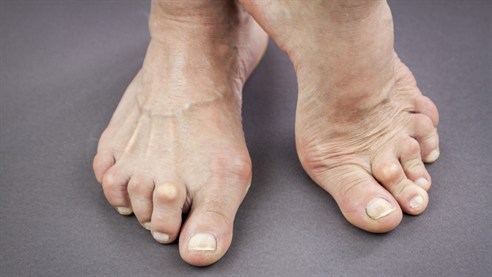Rheumatoid Arthritis in the foot: What is Rheumatoid Arthritis?
Rheumatoid arthritis is an autoimmune disease that affects mostly the smaller joints in the body. This means that it is commonly found in the hands and feet. The term autoimmune disease means that your body attacks some of its own tissue as if it were a foreign invader. It is thought to have some genetic factors and some environmental factors. Recently, being exposed to cigarette smoke is thought to ‘turn on’ the gene that leads to Rheumatoid Arthritis.
The joints in the human body contain some gel-like fluid, called synovial fluid. This helps the bones glide over each other smoothly. The joints are covered in a bag called the synovium or the capsule, which keeps the fluid in place. In Rheumatoid Arthritis in the feet, and elsewhere in the body, this lining becomes overactive, swollen and inflamed. In turn, this leads to deterioration in all of the structures that make up the joint. This includes cartilage, bone, capsule, and ligaments. This can cause a looseness that may lead to collapse of the foot structures. At the same time, weakened ligaments can cause joint deformities. In particular, fingers and toes often ‘drift’ sideways.
It is important to know that Rheumatoid Arthritis is not just a disease of bones. It affects all manner of tissues in the body including the internal organs. Having said that though, more than 90% of people with the condition develop joint symptoms in the foot and ankle.
What are the symptoms of Rheumatoid Arthritis in the Foot?
Unlike other types of arthritis, Rheumatoid Arthritis is often (but not always) quite symmetrical. It commonly presents in both feet and affects the same joints on both feet.
Symptoms may include: limping, loss of joint range of motion, joint redness and warmth and fatigue / lack of tolerance for activity.
How does Rheumatoid Arthritis in the foot affect your life?
Rheumatoid Arthritis can cause a progressive destruction of the ankle joint or foot joints. This can cause simple walking or plain standing to become painful. As the disease progresses, it has the ability to move bones out of their normal positions. This can allow the arch of the foot to collapse and cause the foot to dramatically change shape. Wearing shoes may then become very painful. Even finding shoes that are appropriate can be very difficult. Rheumatoid arthritis commonly causes bunions, claw toes, and pain under the balls of the feet.
With the bony deformities that may develop, the unusual bumps can receive a lot of extra pressure. They can become covered in hardened skin called callus or corns cause pain. If there is too much pressure for the skin to cope with, it can break down in pressure areas, leading to ulceration.
How is rheumatoid arthritis in the foot diagnosed?
Rheumatoid arthritis is usually diagnosed by a doctor. Blood test results form an important part of the examination. Often the results for the items “ESR” and “CRP” will be elevated. These show that there is some sort of inflammatory disease in the body but not necessarily Rheumatoid Arthritis. More specific blood tests include ANA, TNF and Rheumatoid Factor. X-rays, CT scans and MRI may also be used to confirm the diagnosis.
What non-surgical treatments are available when Rheumatoid Arthritis is affecting the feet?
Unfortunately, there is no definitive cure for Rheumatoid Arthritis at this time. The aims of all treatment options are to help patients manage pain, remain active and enjoy the best possible quality of life. Many different treatment options are used together to ease pain and restore function.
Drugs: Your podiatrist (at least in Australia) will not be involved in the pharmaceutical treatment of your Rheumatoid arthritis. This will be managed by your G.P. You may also see a Rheumatologist.
Rest- Depending where you are in the course of the disease, this might mean different things. As a young person with little damage to the joints in your body, you need to find a balance. It is important to be doing enough exercise to keep the body, bones and joints strong and flexible but also to consider the life span of the joints. In general, walking, swimming and cycling are good choices. However, running and other exercises which place great pressure on the joints of the feet may cause your joints to wear quicker.
If you are already affected with joint pain, a podiatrist can do a lot to keep you moving. We can effectively reduce the strain on foot joints and the pain associated with walking. In this way “rest” can mean a mechanical reduction in forces, rather than just more couch time.
Foot Orthotics and their use in Rheumatoid Arthritic feet
Orthotics can help redistribute the pressures being applied to prominent joints in the foot. The primary goal of an orthotic is to even out pressures in the foot. We want to decrease the formation of callus and wear and tear that can cause ulceration and damage to the skin. Although an orthotic will not correct the shape of the foot once deformity has happened, it will help decrease pain associated with Rheumatoid Arthritis. Early orthotic intervention may help to limit some types of deformity – particularly those in the middle foot and hindfoot.
Hard, rigid orthotics are generally not suitable for Rheumatoid Arthritis in the foot. Using different orthotic techniques though, we are able to make softer, customised orthotics to cater for the prominent areas and stressed joints.
If you have Rheumatoid Arthritis in the foot, or any arthritic condition for that matter, it is not too early to see a podiatrist for immediate pain relief and to preserve the foot joints over time.
Find support at Arthritis Queensland.

Recent Comments